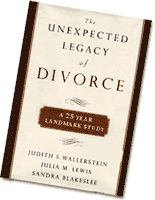Social Science Research | A Research Study | 3 years | 4 years | 5 years | 6 years | 20 years | 26 years | 29 years | 30 years | Today + | Recap
« previous Page 9 of 12 next »
A Book

29 Years Later
September 2000
Findings from the 25-year study are expanded into a book. Judith Wallerstein, Julia Lewis, and Sandy Blakeslee publish The Unexpected Legacy of Divorce: A 25 Year Landmark Study.
Wallerstein, Judith, Julia M. Lewis, and Sandra Blakeslee. The Unexpected Legacy of Divorce: A 25 Year Landmark Study. 1st ed. New York: Hyperion, 2000. ISBN 0-7868-6394-3 Jacket design by Ashwini M. Jambotkar
Books can be popular or scholarly or a combination of both. Widespread popular interest in many social science topics can blur the line between scholarly research and popular books.
The Unexpected Legacy of Divorce is a combination since:
- Wallerstein and Lewis are academic researchers and the book is based upon their study, but the book's content is mostly personal stories about the children in the study and advice for divorced parents
- Blakeslee, a reporter for the New York Times, helps make the book's language understandable for a general audience
- The publisher, Hyperion, specializes in general-interest books and is not a scholarly press
| Popular Book Characteristics | |
| AUDIENCE: | General public |
| AUTHOR: | Journalists, professional writers, or sometimes scholars |
| TIMELINESS: | Not as current as magazines or journals (although books on current events or scandals are sometimes rush released to capitalize on public interest). |
| CONTENT: | Provides more information than a magazine article, but is still a popularized treatment of a subject (such as a book that rewrites scholarly research in simpler language with more personal-interest stories). Does not usually back up information with footnotes and bibliographies citing other research. |
| TYPE OF SOURCE: | Secondary, unless it's an autobiography, diary, or collection of letters |
| Scholarly Book Characteristics | |
| AUDIENCE: | Scholars and students |
| AUTHOR: | Professors or scholars in the field |
| SELECTION PROCESS: | Editorial review |
| TIMELINESS: | Takes at least several years for a book about a research project to be written. |
| CONTENT: | Covers one subject in great depth, or brings together essays on similar topics. Backs up information with footnotes and bibliographies citing other research. |
| TYPE OF SOURCE: | Secondary |
Popular magazines
Popular magazines publish stories about the book. In "Should You Stay
Together for the Kids?" (September 24, 2000), Time reports
on the book's major findings, gives advice to its readers, and relates stories
about children of divorce.
| Popular Magazine Characteristics | |
| AUDIENCE: | General public |
| WRITTEN BY: | Journalists |
| SELECTION PROCESS: | Editorial review |
| TIMELINESS: | Usually several days to a week behind events |
| CONTENT: | Summarizes the research in non-technical terms and uses stories and quotes from individuals to illustrate the findings. Does not publish any new research and does not give footnotes or references for the information. |
| TYPE OF SOURCE: | Primary when reporting on news events. In this case, secondary because the article is reviewing or publicizing a book. |
WANT MORE on magazines?
>: Unit 9 > Evaluating Sources > Type of Periodical
« previous Page 9 of 12 next »
